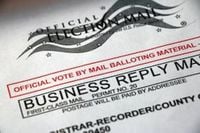On August 18, 2025, President Donald Trump reignited a fierce national debate over the future of American elections, announcing at the White House his plan to eliminate mail-in voting and voting machines nationwide ahead of the 2026 midterm elections. The announcement, made first on his Truth Social platform and reiterated in meetings with both Russian President Vladimir Putin in Alaska and Ukrainian President Volodymyr Zelenskyy in Washington, has drawn swift condemnation from election officials, legal experts, and political leaders across the spectrum.
Trump’s pledge marks an escalation in his ongoing campaign to reshape U.S. election procedures, one that leans heavily on conspiracy theories and misinformation about the security of mail-in ballots and voting technology. According to the Associated Press, Trump declared, “We’re going to start with an executive order that’s being written right now by the best lawyers in the country to end mail in ballots because they’re corrupt.” He went on to claim, “It’s time that the Republicans get tough and stop it, because the Democrats want it. It’s the only way they can get elected.”
Yet, as multiple outlets including NewsOne and The Daily News have reported, Trump’s assertions about mail-in voting are riddled with inaccuracies. In a Fox News interview following his Alaska summit with Putin, Trump quoted the Russian leader as having said, “America’s 2020 election was rigged because of mail-in voting,” and added, “no country” uses the practice. In reality, a 2024 report from the International Institute for Democracy and Electoral Assistance found that 34 countries or territories allow mail-in voting, with 12 permitting all voters to use it and 22 allowing it for select groups. Among them: Germany, Switzerland, and the United Kingdom.
Ironically, as The Daily News points out, mail-in voting and voting machines are the very systems that enabled Trump to win the 2024 election and helped Republicans secure control of Congress. Roughly one-third of U.S. voters cast ballots by mail, and voting machines—some form of which exist in nearly all of the country’s thousands of election jurisdictions—remain a backbone of the American electoral process.
Despite these facts, Trump’s rhetoric has only intensified. On Truth Social, he insisted that states “must do what the Federal Government, as represented by the President of the United States, tells them.” He described states as “merely an ‘agent’ for the Federal Government in counting and tabulating the votes.” Legal scholars and state officials were quick to rebut these claims. Rick Hasen, an election law professor at UCLA, told The Daily News, “The president has very limited to zero authority over things related to the conduct of elections.” The Constitution places the power to determine the “times, places and manner” of elections firmly in the hands of state legislatures, with Congress able to regulate certain aspects—but not the president.
Trump’s latest executive order, which would reportedly require documented proof-of-citizenship before registering to vote, is already facing legal challenges. Washington and Oregon, which have long conducted their elections entirely by mail, have sued the administration, arguing that the president lacks the authority to set such rules. They are seeking a federal declaration that their state postmark deadlines for ballots do not conflict with federal law.
Oregon Secretary of State Tobias Read minced no words, calling Trump’s proposal “un-American, unconstitutional, and unacceptable.” In a statement to NewsOne, he said, “Abandoning this trusted system for one man’s political ambitions is un-American, unconstitutional, and unacceptable. We do not cancel elections. We do not silence voters. And we do not let personal grievances undermine democracy.” Arizona Secretary of State Adrian Fontes added, “Despite what Putin apparently whispered into President Trump’s ears, our vote-by-mail elections are secure and accurate. Voter fraud is extremely rare, and it’s never changed the outcome of an election.”
Indeed, evidence of widespread fraud in mail-in voting is scant. An Associated Press review after the 2020 election found fewer than 475 cases of potential fraud in six battleground states—far too few to impact the outcome. Conservative networks that aired similar complaints about mail voting have faced multimillion-dollar defamation settlements after failing to provide evidence for their claims.
Mail-in voting, once a Republican stronghold—especially in states like Florida—has become a wedge issue since Trump began attacking it during the COVID-19 pandemic. Mac Stipanovich, a longtime Florida GOP operative, told NewsOne, “There was a time when Republicans owned and relied on voting by mail. Now, Trump has turned voter suppression into party dogma, at the expense of his own side.” Strategists warn that discouraging absentee ballots could depress Republican turnout, particularly among rural and elderly voters who rely on the convenience of voting from home.
Trump’s attacks on voting machines are equally fraught. He alleged that they are more expensive than “Watermark Paper,” a system favored by some conspiracy theorists. But, as The Daily News notes, most U.S. voters already use paper ballots, which provide an auditable record and extra security. Watermarks, while touted by some as a fraud prevention tool, do not offer a method for counting ballots and would not replace voting machines.
Even within the Republican Party, there is skepticism about Trump’s proposed changes. A former Trump campaign official admitted, “From a pure tactics standpoint, it is not helpful. This is where he starts getting into conspiratorial spaces where independent voters are like, ‘What is he talking about?’”
Democratic leaders have vowed to block any federal efforts to restrict mail-in voting. Senate Majority Leader Chuck Schumer promised, “Senate Democrats will make sure that any and every measure that would make it even more difficult for Americans to vote will be dead on arrival in the Senate and will continue to fight to protect our democracy.”
Experts widely agree that any executive order or legislation to eliminate mail-in voting or voting machines would face immediate legal and political obstacles. Courts have already blocked parts of Trump’s earlier orders, and even with Republican control of Congress, Democrats could filibuster new restrictions. More fundamentally, the president is simply not empowered to dictate how states run their elections.
Yet, the danger, as many observers see it, lies less in the legal prospects of Trump’s plans and more in the normalization of anti-democratic rhetoric. By branding mail-in ballots as “corrupt” and sowing doubt about the reliability of voting technology, Trump is laying the groundwork to challenge election results that do not favor him—a tactic reminiscent of his efforts after the 2020 election that fueled the January 6 insurrection.
As the nation heads toward another pivotal election cycle, the fight over how Americans cast their ballots is shaping up to be as much about trust in democracy as it is about the mechanics of voting itself. The stakes could not be higher, and the outcome will reverberate far beyond 2026.



